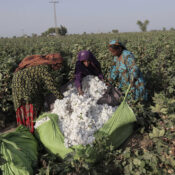
Understanding the Consequences, Seeking Solutions, and Ensuring Food Security for a Changing Climate
Subtitle: Navigating the Complexities of Agricultural Disruptions and Promoting Resilient Food Systems
Introduction:
In a world facing the challenges of a changing climate, disruptions to agricultural systems and the threat of food scarcity loom large. Climate change, with its adverse effects on weather patterns, soil fertility, and water availability, poses significant risks to food production and distribution. This essay explores the consequences of climate-related disruptions on agricultural systems and the urgent need for solutions to ensure food security in the face of a changing climate.

- Climate Change and Agricultural Systems:
Climate change impacts various components of agricultural systems, including temperature, precipitation, and extreme weather events. Rising temperatures affect crop growth and development, altering phenological processes and reducing yields. Changes in precipitation patterns can lead to droughts, floods, and erratic rainfall, disrupting planting, irrigation, and harvest schedules. Heatwaves and extreme weather events can further damage crops and agricultural infrastructure, exacerbating risks to food production. - Reduced Crop Yields and Loss of Productivity:
Rising temperatures, changing rainfall patterns, and increased frequency of extreme weather events significantly impact crop yields and agricultural productivity. Heat stress, water scarcity, and increased pest and disease prevalence can lead to crop failures and decreased agricultural output. Small-scale farmers and subsistence agriculture are particularly vulnerable, facing financial losses, compromised livelihoods, and increased food insecurity. - Challenges in Livestock and Fisheries:
Climate change not only affects crop production but also poses challenges to livestock and fisheries. Heat stress impacts livestock health and productivity, leading to reduced milk and meat production. Changing temperature and precipitation patterns also affect the productivity and distribution of fisheries, compromising the livelihoods of millions dependent on marine resources. These disruptions in the livestock and fisheries sectors further contribute to food scarcity and economic hardships. - Water Scarcity and Irrigation Challenges:
Increasing temperatures coupled with changing rainfall patterns pose significant challenges to water availability for agriculture. Droughts and water scarcity affect irrigation systems, reducing water availability for crops. Inefficient irrigation practices further exacerbate the problem, leading to water wastage and limited access to water for farming. Promoting sustainable water management practices and efficient irrigation systems becomes crucial for adapting to a changing climate and ensuring adequate water supply for agriculture. - Shifting Agricultural Zones and Threats to Biodiversity:
As climate patterns change, suitable agricultural zones shift, altering the landscapes where specific crops can thrive. This can lead to challenges for farmers who rely on traditional crop varieties and farming methods adapted to local conditions. Additionally, changes in temperature and precipitation patterns pose risks to agricultural biodiversity, with potential implications for food security and resilience. Efforts to conserve agricultural biodiversity and develop climate-resilient crop varieties are vital for adapting to changing agricultural conditions.

6. Innovations and Adaptive Farming Practices:
In response to climate disruptions, innovative farming practices and technologies are emerging. These include climate-smart agriculture techniques, such as conservation agriculture, agroforestry, and precision farming, which promote sustainable land use, better water management, and improved soil fertility. The application of advanced technologies, like remote sensing and weather forecasting, also offer valuable tools for farmers to adapt to changing climatic conditions and optimize resource utilization for enhanced productivity.
7. Strengthening Resilience and Promoting Sustainable Food Systems:
Building resilience in agricultural systems and ensuring food security in the face of climate change requires holistic approaches. This includes promoting sustainable farming practices, diversifying crops and income sources, integrating agroecology principles, and investing in climate-resilient infrastructure. Building local capacity, supporting small-scale farmers, and enhancing regional coordination in agricultural planning and disaster preparedness are also crucial for fostering resilient food systems.
8. Collaboration and Policy Interventions:
Addressing the challenges of disrupted agricultural systems and food scarcity requires concerted efforts from multiple stakeholders. Governments, international organizations, and the private sector must collaborate to develop and implement policies that support climate-smart agriculture, incentivize sustainable practices, and provide financial and technical support to farmers. Strengthening research and knowledge sharing platforms also play a pivotal role in identifying effective adaptation strategies and disseminating best practices.
All Categories
- Agricultural Methods
- Agriculture and Women Small Farmers Rights Awareness
- Climate Change
- Disable and Human Rights
- Disable Jobs
- Donation
- Education
- Health Issues
- Organic Foods
- Organic Vegetables
- Orphans Children
- Plastic production and disposal
- Services
- Sinking in Scarcity
- Success Stories
- Uncategorized
- Waste Management
- Women Rights
- Youth Empowerment




